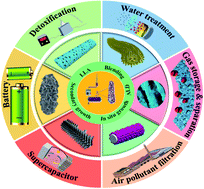Electrospun metal–organic framework based nanofibers for energy storage and environmental applications: current approaches and challenges
Abstract
In recent years, a great deal of investigation has been performed based on the study of metal–organic frameworks (MOFs) combined with other materials, in order to overcome the tremendous challenge encountered by single MOFs in practical applications. Among them are MOF based composite nanofibers prepared via electrospinning with the advantages of inorganic porous materials and polymeric nanofibers, which have witnessed intensive development and extensive applications in energy storage and environment conservation fields. Beyond that, preparing MOF based composite nanofibers is also considered to be an effective route to broaden the practical application of MOFs. Herein, a comprehensive review of the recent developments of MOF based composite nanofibers prepared via the electrospinning process, serving as functional materials, is provided. From the perspective of fabrication, the major routes reported so far for fabricating MOF based composite nanofibers are first systematically discussed. Furthermore, the fundamental applications of MOF based composite nanofibers in energy storage and environmental protection are introduced in detail. Finally, a series of critical challenges in the above research area, and some directions for future research are put forward.



 Please wait while we load your content...
Please wait while we load your content...